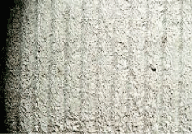 |
| Typical A/C COIL loaded with mold & debris - a major bionesting source |
|
|
|
A/C COIL, LARGEST MOLD SOURCE
There is a direct relationship between bionesting, debris and efficiency of the system. The biggest HVAC bionesting source and wasted energy is the A/C evaporative coil:
1. The dark, damp conditions of A/C coil are ideal for the growth of thousands of mold colonies.
2. The coil is perhaps the largest source of indoor molds.
3. Coil molds are the source of "Dirty Sock Syndrome" and organic acids.
4. It's estimated that molds are the primary cause of 80 percent of allergies & asthma.
5. It's estimated that a build up of .042 inches (thickness of sandwich wrap) of debris on the coil can decrease system efficiency by 21 percent.
|
 |
| Typical HVAC FILTER loaded with germs & debris - a major bionesting source |
|
|
|
Indoor Air Is Highly Polluted
The indoor air is more contaminated than ever ? up to 7 times more toxins, germs and house dust than fifty years ago. The Science Advisory Board (EPA) ranks indoor air pollution among the top four environmental risks to public health. They are:
1. Nuclear waste.
2. Outdoor pollutants & green house gases.
3. Super toxic dump sites.
4. Indoor air quality (Iamb)
There are many causes for the increased levels of indoor pollution:
· Energy tight buildings trap contaminates indoors with little fresh air relief.
· HVAC fan powers contaminates throughout home.
· Modern building material out-gassing.
· Higher indoor moisture gives rise to mold and dust-mite growth.
· Higher use of cleaning and other chemical products.
· Higher indoor microbial growth and debris dissemination.
· More concentrated human by-products (hair, dander, dead skin, etc) from increased indoor living.
· Higher presence of insect, dust mite and cockroach feces and body parts.
· Infesting growth within the HVAC unit (perhaps the largest source of indoor pollutants).
|
|
Major Pollution Source
The HVAC system produces and circulates the highest content of home indoor pollution in two ways:
1. When the HVAC fan operates, it pulls a volume of indoor air equal to 100-percent of the building's air volume about every 8-12 minutes. Pollution is dragged into the system and back out again, distributed to every nook and cranny of the building.
2. Because of biological nesting, the HVAC filter and A/C coil generally account for the highest source of contamination in the home. It is estimated that the HVAC system produces up to 6-times more indoor pollution (toxins, germs, molds, allergens, house dust) than any other source.
|
|
Types of HVAC Pollutants
Pollutants and toxins come from bionesting within the system, and are circulated by the fan. The HVAC system not only grows contaminates, but is the mechanism by which debris is propelled back into the breathable space. The pollutants generated by the HVAC are:
· Pathogenic organisms (bacteria and mold).
· Toxic metabolic gases (benzene, formaldehyde) from microbial growth
· Aggressive allergens, i.e., mold spores and mycelium enzymes.
· Microbial debris, dust and body parts.
|
|